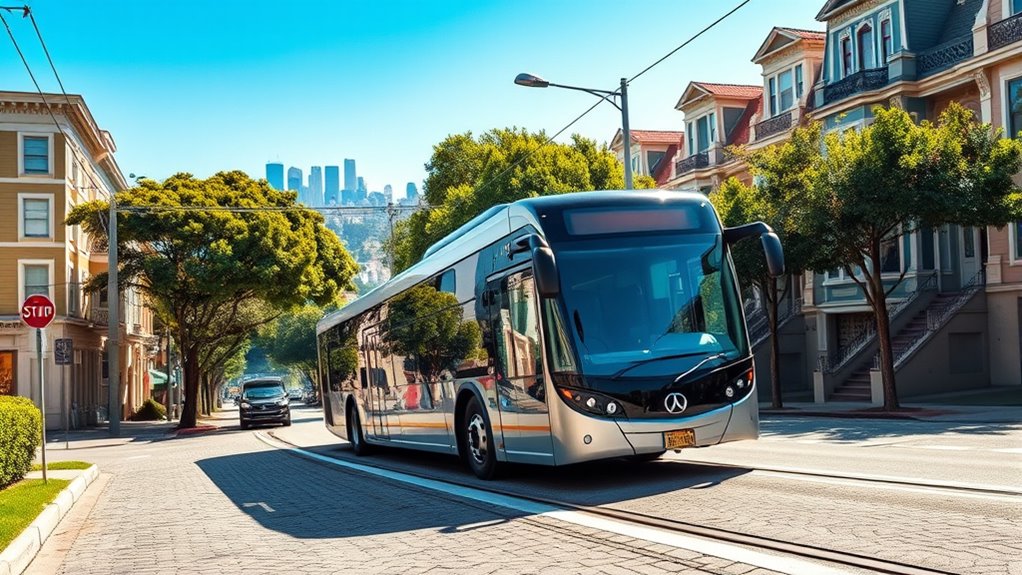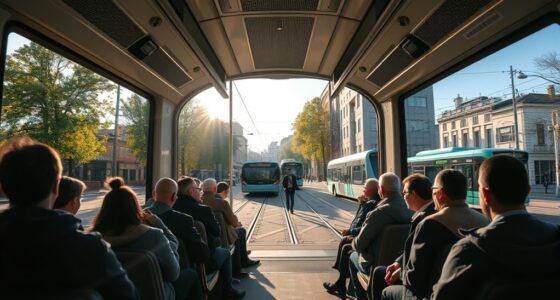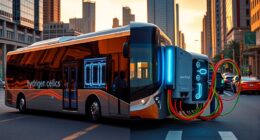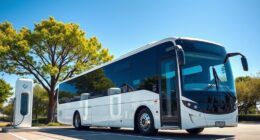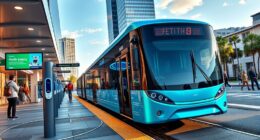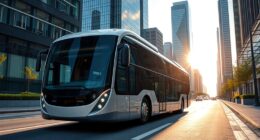Electric buses manage San Francisco’s steep hills by using regenerative braking to recover energy and advanced motor control for stability. They adapt their speed and power, ensuring a smooth ride and passenger comfort while tackling tough inclines. Monitoring batteries carefully prevents mid-route depletions, and improved technology boosts hill-climbing ability. If you want to understand how these buses maintain performance and efficiency on such challenging terrain, there’s more to uncover below.
Key Takeaways
- Regenerative braking in electric buses recovers energy on steep downhill slopes, extending range and reducing energy consumption.
- Advanced motor control maintains stability and power during steep climbs, preventing stalls and ensuring safety.
- Proper route planning and battery monitoring help prevent mid-journey depletion on hilly San Francisco streets.
- Electric buses deliver smoother, quieter rides with controlled acceleration and descent, enhancing passenger comfort on steep terrain.
- Ongoing battery innovations improve hill-climbing performance, optimizing efficiency and reliability on San Francisco’s steep streets.
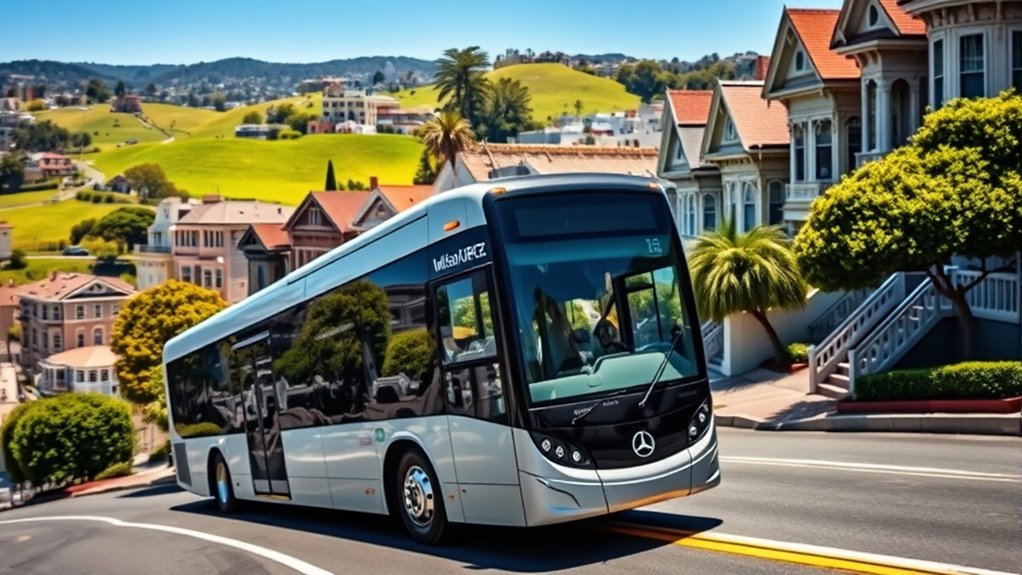
San Francisco’s famous hills can be both breathtaking and challenging, especially if you’re new to traversing this city’s steep terrain. As an electric bus operator or rider, understanding how these inclines impact your experience is vital. Steep streets demand more from the bus’s battery, which directly influences battery efficiency. When climbing hills, the electric motor works harder, consuming more power and reducing overall range. This means you need to plan routes carefully, especially during long shifts, to guarantee the bus doesn’t run out of charge mid-journey. Good battery management becomes essential to keep the bus operating smoothly, avoiding unexpected delays or the need for frequent recharges. Modern electric buses are designed to maximize battery efficiency through regenerative braking, which recovers energy during downhill segments, helping to extend range and reduce energy consumption. As a rider, you’ll notice that these buses often slow down slightly on steep inclines, but thanks to advanced motor control systems, they maintain stability and performance without sacrificing power. This balance is key to ensuring the bus can climb hills without stalling or losing momentum, which can be uncomfortable for passengers and disruptive to schedules. Comfort on these steep routes depends heavily on how well the bus’s suspension handles the terrain. Electric buses tend to have smoother acceleration and deceleration, which benefits rider comfort, especially on uneven or steep roads. When the bus climbs a hill, the system modulates power delivery smoothly, preventing jerks or abrupt movements that could unsettle passengers. The quiet operation of electric motors also contributes to a more comfortable ride, reducing noise and vibrations that are common in traditional diesel-powered vehicles. On downhill stretches, regenerative braking not only conserves energy but also ensures a gentle, controlled descent, adding to passenger comfort and safety. As a rider, you’ll appreciate the consistent, stable ride even on San Francisco’s notorious hills. From a practical standpoint, operators need to monitor battery levels closely and adapt driving styles to maximize efficiency and comfort. This involves gentle acceleration, maintaining steady speeds, and anticipating stops to minimize abrupt braking. Additionally, ongoing innovations in battery technology continue to enhance the ability of electric buses to handle the city’s most challenging terrain with greater ease. Overall, navigating San Francisco’s hills in an electric bus hinges on balancing battery efficiency with rider comfort. When managed well, these buses can handle steep inclines with ease, providing a smooth, quiet ride that’s both efficient and comfortable for everyone onboard. With ongoing advancements in battery technology and vehicle design, electric buses are becoming increasingly capable of conquering the city’s most challenging terrain while maintaining excellent performance.
Frequently Asked Questions
How Do Electric Buses Handle Sudden Weather Changes on Steep Streets?
You’ll find that electric buses handle sudden weather changes on steep streets well, thanks to solar integration and regenerative braking. Solar panels help maintain battery power during cloudy days, ensuring consistent performance. Regenerative braking captures energy when slowing down, which is especially useful on slippery or rainy hills. These features work together, providing reliable handling and safety even when weather conditions shift unexpectedly.
What Maintenance Challenges Are Unique to Electric Buses on Hilly Routes?
You’ll find that electric buses on hilly routes face unique maintenance challenges, like accelerated battery degradation due to constant climbs and descents. Regenerative braking helps reduce wear, but over time, it can still impact battery health. You’ll need to monitor battery performance closely and perform regular maintenance to prevent potential issues. Studies show that steep terrain can shorten battery lifespan by up to 20%, making proactive upkeep essential.
How Do Battery Performances Vary During Long Hill Climbs?
During long hill climbs, you’ll notice your electric bus’s battery performance can decrease due to battery degradation, which affects capacity over time. To optimize performance, adopt effective charging strategies like frequent top-ups before steep routes, ensuring the battery remains sufficiently charged. Proper management helps maintain consistent power, reduces strain on the battery, and extends its lifespan, making your bus more reliable on those challenging, long hill climbs.
Are There Specific Electric Bus Models Optimized for San Francisco’s Terrain?
Yes, some electric bus models are tailored for San Francisco’s terrain by enhancing battery efficiency and motor torque. You’ll find these buses designed with stronger motors and better battery management systems, allowing them to handle steep hills with less power loss. This means you’ll experience smoother climbs and reliable performance, even on the city’s challenging inclines. Look for models specifically built for hilly environments to guarantee peak performance on San Francisco’s steep streets.
How Do Steep Inclines Affect Passenger Comfort and Safety?
Steep inclines can challenge passenger stability, making it feel like you’re leaning or unsteady. To guarantee your safety, buses are equipped with safety protocols like secure handrails and anti-slip flooring. Passengers should hold onto handrails and sit during steep climbs to stay safe. Comfort is maintained through smooth acceleration and braking, but always pay attention to safety instructions to minimize any risk during these challenging terrains.
Conclusion
Ultimately, mastering San Francisco’s steep streets demands diligence, determination, and daring. Electric buses boldly break barriers, showcasing strength and sustainability on seemingly savage slopes. As you traverse these tumultuous terrains, remember that resilience and innovation work hand in hand. Embrace the exhilarating challenge, knowing that each ascent amplifies your awareness and appreciation. Moving through these notable hills becomes a nurturing narrative of progress, perseverance, and pioneering power—proof that perseverance and progress propel us past the peaks.
